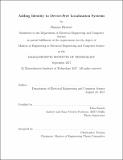| dc.contributor.advisor | Dina Katabi. | en_US |
| dc.contributor.author | Hristov, Rumen (Rumen H.) | en_US |
| dc.contributor.other | Massachusetts Institute of Technology. Department of Electrical Engineering and Computer Science. | en_US |
| dc.date.accessioned | 2018-12-11T20:38:41Z | |
| dc.date.available | 2018-12-11T20:38:41Z | |
| dc.date.copyright | 2017 | en_US |
| dc.date.issued | 2017 | en_US |
| dc.identifier.uri | http://hdl.handle.net/1721.1/119523 | |
| dc.description | Thesis: M. Eng., Massachusetts Institute of Technology, Department of Electrical Engineering and Computer Science, 2017. | en_US |
| dc.description | This electronic version was submitted by the student author. The certified thesis is available in the Institute Archives and Special Collections. | en_US |
| dc.description | Cataloged from student-submitted PDF version of thesis. | en_US |
| dc.description | Includes bibliographical references (pages 57-59). | en_US |
| dc.description.abstract | Recent advances in wireless localization systems show that by transmitting a wireless signal and analyzing its reflections, one can localize a person and track her vital signs without any wearables. These systems can localize with high accuracy even when multiple people are present in the environment. However, a primary limitation is that they cannot identify people and know who is the monitored person. In this thesis, we present a system for identifying people based only on their wireless reflection with high accuracy. We use a semi-supervised learning classifier to assign labels to each person tracked by the device-free localization system. We use recent advances in machine learning to leverage the big amount of unsupervised data that we have. A key challenge that we solve is obtaining labels that are used for guiding the classifier. To get labeled data, we devised a novel scheme to combine data from a sensor that people are carrying with data from a wireless localization system. We deployed and evaluated our system in people's homes. We present a case study of how it can be helpful to monitor people's health more effectively. | en_US |
| dc.description.statementofresponsibility | by Rumen Hristov. | en_US |
| dc.format.extent | 59 pages | en_US |
| dc.language.iso | eng | en_US |
| dc.publisher | Massachusetts Institute of Technology | en_US |
| dc.rights | MIT theses are protected by copyright. They may be viewed, downloaded, or printed from this source but further reproduction or distribution in any format is prohibited without written permission. | en_US |
| dc.rights.uri | http://dspace.mit.edu/handle/1721.1/7582 | en_US |
| dc.subject | Electrical Engineering and Computer Science. | en_US |
| dc.title | Adding identity to device-free localization systems | en_US |
| dc.type | Thesis | en_US |
| dc.description.degree | M. Eng. | en_US |
| dc.contributor.department | Massachusetts Institute of Technology. Department of Electrical Engineering and Computer Science | |
| dc.identifier.oclc | 1066694412 | en_US |
